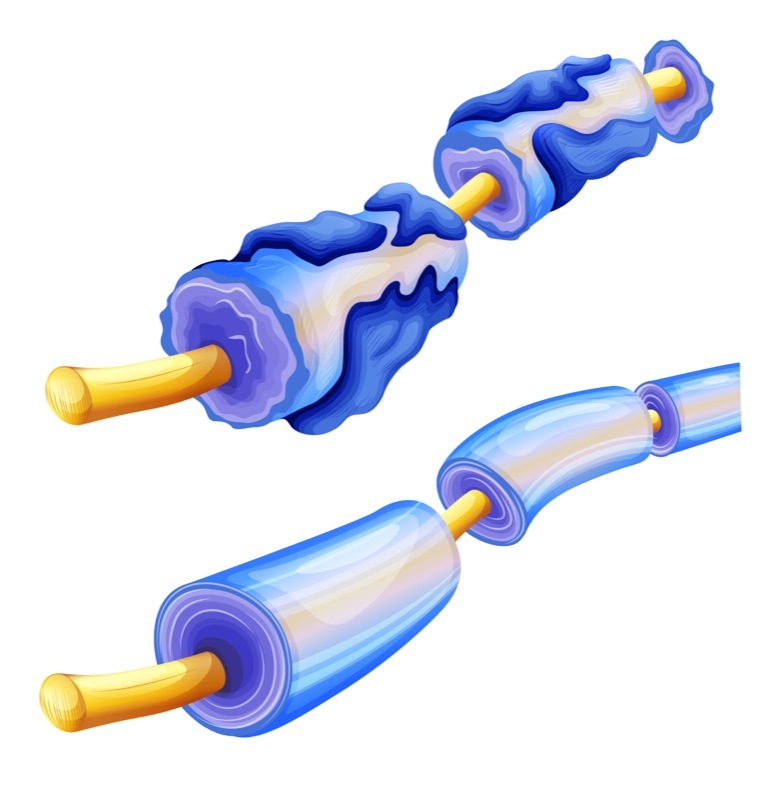Ep400 Protein Required for the Normal Function of Myelin-producing Schwann Cells, Mouse Study Shows
Written by |

Schwann cells — those responsible for the production of the myelin protective layer in peripheral nerve cells — fail to develop normally in the absence of a protein called Ep400, a new mouse study shows.
A lack of Ep400 locks the cells in an immature state characterized by defective myelin sheaths in the peripheral nerves — the cells that are damaged in Charcot-Marie Tooth (CMT). These findings suggest that therapeutic modulation of Ep400 may be useful for diseases such as CMT.
The study, “Ep400 deficiency in Schwann cells causes persistent expression of early developmental regulators and peripheral neuropathy,” was published in the journal Nature Communications.
A research team from Friedrich-Alexander-Universität Erlangen-Nürnberg, led by Franziska Fröb and Michael Wegner in Germany, has been studying Schwann cells for many years. These cells are responsible for producing the protective fatty layer, called the myelin sheath, around peripheral nerve cells, which are damaged in CMT.
Myelin works like the insulation on electrical cables, and allows the efficient transmission of nerve signals. Damage to the myelin sheath impairs the exchange of information in nerve cells but these cells may also die prematurely, as Schwann cells provide them with key nutrients.
While the proteins and protein complexes required for Schwann cells to perform their functions have been largely identified, how proteins interact and maintain a network is not well understood.
“We will only be able to consider possible therapies once we have gained a better understanding of the networks,” Wegner said in a news release.
The researchers investigated the role of a protein, called Ep400, that they have recently identified in Schwann cells and is a key subunit of a protein complex, called the Tip60/Ep400.
In their study, they deleted the protein at different stages of embryonic development in mice, starting on embryonic day 12.5. Once Ep400 was deleted, its protein complex was no longer functional.
In Ep400-deficient mice on day 21, about 25% of the nerve cells’ larger-calibre axons (the slender projections out of neurons) lacked myelin, whereas the peripheral nerves were fully protected in control mice, the researchers observed. Moreover, the myelin sheath was found to be shorter and thinner in these mice, compared with the healthy mice.
While the researchers saw some improvements in myelination when the mice were two months old, myelin degeneration was still occurring, as well as a damaging inflammatory response.
Ep400 was required for the correct packaging of DNA in Schwann cells, the researchers found, so that genetic information is found and read at the right time.
Specifically, when researchers deleted Ep400 and analyzed mice shortly after birth — a period of active myelination — the number of myelin-producing Schwann cells was reduced and their production was found to be defective. The cells were locked in a more premature state, as shown by the high levels of the Tfap2a gene. Tfap2a protein is naturally produced early during embryonic development, but in the absence of Ep400, this protein continued to be expressed in Schwann cells two months after birth.
When the researchers deleted Tfap2a in Ep400-deficient cells, they were able to rescue some of the Schwann cells’ defects.
“We are, of course, pleased that we have made such a significant step forward in understanding the complex interdependencies within the Schwann cells,” Wegner said.
“Our results indicate that DNA structural changes induced by proteins such as Ep400 are extremely important and may also be useful in future to develop therapies for peripheral neuropathy,” he added.
The researchers hope that their findings will help in the treatment of patients with neuropathy diseases such as CMT.




